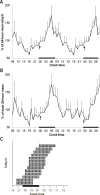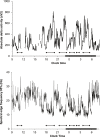Temporal disorganization of circadian rhythmicity and sleep-wake regulation in mechanically ventilated patients receiving continuous intravenous sedation
- PMID: 22851806
- PMCID: PMC3397814
- DOI: 10.5665/sleep.1998
Temporal disorganization of circadian rhythmicity and sleep-wake regulation in mechanically ventilated patients receiving continuous intravenous sedation
Abstract
Objectives: Sleep is regulated by circadian and homeostatic processes and is highly organized temporally. Our study was designed to determine whether this organization is preserved in patients receiving mechanical ventilation (MV) and intravenous sedation.
Design: Observational study.
Setting: Academic medical intensive care unit.
Patients: Critically ill patients receiving MV and intravenous sedation.
Methods: Continuous polysomnography (PSG) was initiated an average of 2.0 (1.0, 3.0) days after ICU admission and continued ≥ 36 h or until the patient was extubated. Sleep staging and power spectral analysis were performed using standard approaches. We also calculated the electroencephalography spectral edge frequency 95% SEF₉₅, a parameter that is normally higher during wakefulness than during sleep. Circadian rhythmicity was assessed in 16 subjects through the measurement of aMT6s in urine samples collected hourly for 24-48 hours. Light intensity at the head of the bed was measured continuously.
Measurements and results: We analyzed 819.7 h of PSG recordings from 21 subjects. REM sleep was identified in only 2/21 subjects. Slow wave activity lacked the normal diurnal and ultradian periodicity and homeostatic decline found in healthy adults. In nearly all patients, SEF₉₅ was consistently low without evidence of diurnal rhythmicity (median 6.3 [5.3, 7.8] Hz, n = 18). A circadian rhythm of aMT6s excretion was present in most (13/16, 81.3%) patients, but only 4 subjects had normal timing. Comparison of the SEF₉₅ during the melatonin-based biological night and day revealed no difference between the 2 periods (P = 0.64).
Conclusions: The circadian rhythms and PSG of patients receiving mechanical ventilation and intravenous sedation exhibit pronounced temporal disorganization. The finding that most subjects exhibited preserved, but phase delayed, excretion of aMT6s suggests that the circadian pacemaker of such patients may be free-running.
Keywords: Critical illness; circadian rhythm; intensive care; melatonin; polysomnography; sedation; sleep; slow wave activity; ventilator.
Figures





Comment in
-
Sleep, circadian rhythms, and critical illness.Sleep. 2012 Aug 1;35(8):1029-30. doi: 10.5665/sleep.1980. Sleep. 2012. PMID: 22851797 Free PMC article. No abstract available.
-
Typical sleep patterns are absent in mechanically ventilated patients and their circadian melatonin rhythm is evident but the timing is altered by the ICU environment.Aust Crit Care. 2014 Aug;27(3):151-3. doi: 10.1016/j.aucc.2014.01.001. Epub 2014 Feb 18. Aust Crit Care. 2014. PMID: 24556537 No abstract available.
References
-
- Meerlo P, Sgoifo A, Suchecki D. Restricted and disrupted sleep: effects on autonomic function, neuroendocrine stress systems and stress responsivity. Sleep Med Rev. 2008;12:197–210. - PubMed
Publication types
MeSH terms
Substances
Grants and funding
LinkOut - more resources
Full Text Sources
Medical

